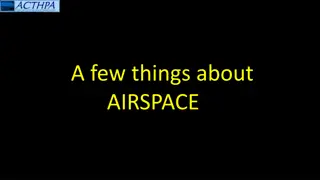Advanced Techniques for Quadrotor Flight Control
The research paper discusses thrust mixing, saturation, and body-rate control for precise and aggressive quadrotor flight. It covers system overview, dynamical system modeling, LQR control design, trajectory tracking performance, disturbance rejection, body torque estimation, and iterative thrust mixing approaches. The proposed methods aim to enhance quadrotor maneuverability and stability through advanced control strategies.
Download Presentation

Please find below an Image/Link to download the presentation.
The content on the website is provided AS IS for your information and personal use only. It may not be sold, licensed, or shared on other websites without obtaining consent from the author.If you encounter any issues during the download, it is possible that the publisher has removed the file from their server.
You are allowed to download the files provided on this website for personal or commercial use, subject to the condition that they are used lawfully. All files are the property of their respective owners.
The content on the website is provided AS IS for your information and personal use only. It may not be sold, licensed, or shared on other websites without obtaining consent from the author.
E N D
Presentation Transcript
Thrust Mixing, Saturation, and Body-Rate Control for Accurate Aggressive Quadrotor Flight Matthias Faessler, Davide Falanga, and Davide Scaramuzza IEEE Robotics and Automation Letters (RA-L)
System Overview High-Level Part Low Level Part Position Controller Body Rate Controller Cmds Body Rates Collective Thrust Body Torques Collective Thrust Mixer Motors Matthias Faessler Robotics and Perception Group University of Zurich 2
Dynamical System Body-rate dynamics Additionally consider single rotor thrust dynamics Resulting body-torque dynamics Dynamical system with body rates and body torques as states Matthias Faessler Robotics and Perception Group University of Zurich 3
LQR Control Design Dynamical system Design infinite horizon LQR controller Resulting LQR control law with feed forward terms Matthias Faessler Robotics and Perception Group University of Zurich 4
Controller Trajectory Tracking Performance Matthias Faessler Robotics and Perception Group University of Zurich 5
Controller Disturbance Rejection Matthias Faessler Robotics and Perception Group University of Zurich 6
Body Torque Estimation Integrate first-order thrust dynamics Load-cell step-input experiments Matthias Faessler Robotics and Perception Group University of Zurich 7
Idea Behind Proposed Thrust Mixing Thrust mixing means finding ?1, ?2, ?3, ?4 s.t. Rotor thrust and drag-torque model Individual torque to thrust ratio Matthias Faessler Robotics and Perception Group University of Zurich 8
Iterative Thrust Mixing Initialize iteration Using rotor thrust and drag torque model Iterate Matthias Faessler Robotics and Perception Group University of Zurich 9
Yaw Control Performance Matthias Faessler Robotics and Perception Group University of Zurich 10
Idea Behind Handling Motor Saturations Recall thrust mixing Example: one motor saturates Proposed prioritizing saturation Matthias Faessler Robotics and Perception Group University of Zurich 11
Prioritizing Motor Saturation Matthias Faessler Robotics and Perception Group University of Zurich 12
Computation Times Matthias Faessler Robotics and Perception Group University of Zurich 13
Video Matthias Faessler Robotics and Perception Group University of Zurich 14























